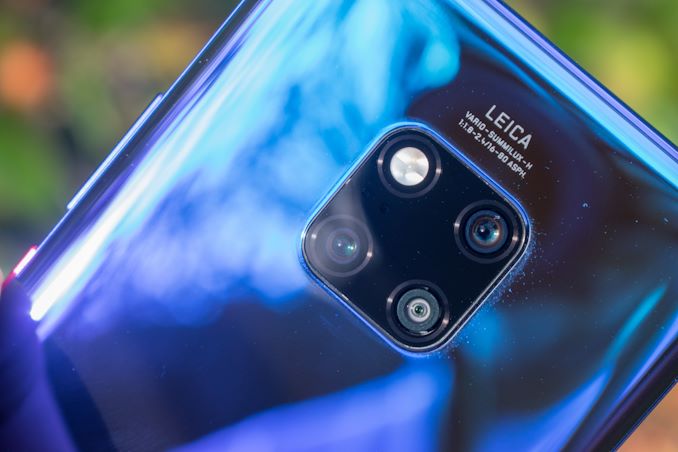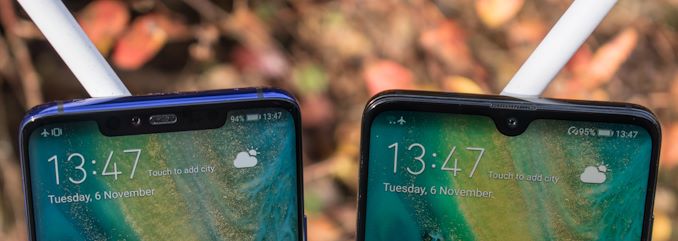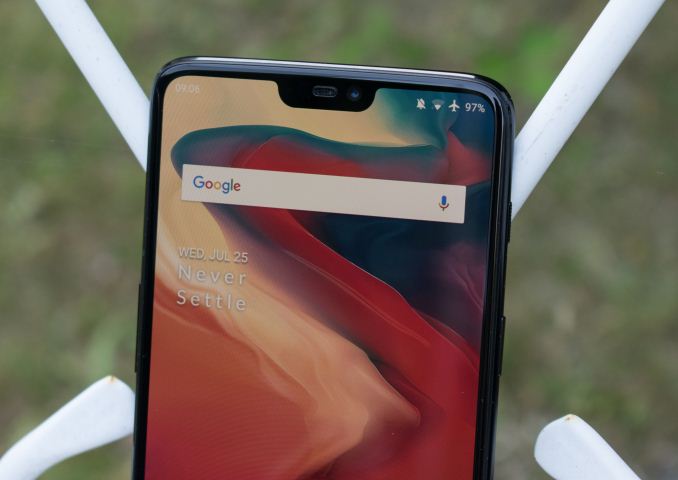AnandTech Year In Review 2018: Flagship Mobile
by Andrei Frumusanu on December 28, 2018 12:00 PM EST- Posted in
- Smartphones
- Apple
- Samsung
- LG
- Huawei
- Mobile
- SoCs
- OnePlus
- Year In Review

As we’re drawing to a close of the calendar year, it is time to look back and revisit what 2018 has brought to the mobile space. Unlike the PC industry, the mobile space follows a quite unrelenting and precise release schedule – meaning that we’re guaranteed new products every year: This can be a double-edged sword for new flagship mobile devices, as new technologies can be either ready at the leading edge of a new product cycle – or in the worst case they can miss the current generation altogether by a few months and have to be relegated to the next generation. Overall, smartphone companies have an incredibly complex task at hand in attempting to deliver products that not only represent an improvement to last year’s devices, but also to be able to distinguish themselves from the current competition. In this piece, we’ll have a closer look at the distinguishing trends of 2018 and how major players have executed their strategies this cycle.
How 2018 Will Be Remembered: Major Smartphone Camera Leaps
If I were to be asked what 2018’s flagship smartphones most defining characteristic would be, then I’d say their cameras. Essentially every vendor in 2018 has made significant leaps in terms of their camera performance, improving quality and adding new features. This year more than ever, we saw a significant amount of products make the camera their key selling point.
Starting off early in the year, Samsung lead the way with the release of the Galaxy S9. The S9’s camera on paper wasn’t too unusual, apart from the fact that the main camera module employed a new innovative dual-aperture mechanism. Samsung’s gains here were defined by sheer improvements of the camera hardware: The new sensor along with the new lens mechanism had raised the bar in terms of overall detail and sharpness, an aspect of the camera in which Samsung still maintains top marks up till today.
Another player whose camera improvements can be attributed to significant hardware leaps is Apple. The new iPhone XS and XR’s new camera module saw a major improvements in the sensor, with new larger pixels as well as a notably improved DTI implementation. The combination of great hardware and robust and consistent software processing made the new iPhone XS one of the best cameras of 2018.
The Year Where Camera Software Outshone Camera Hardware
Although Samsung’s and Apple’s camera improvements were significant – it was more or less an expected result of the newer generation hardware. While the hardware advances this year were solid, nothing left a quite an as quite as lasting impression as Huawei’s new computational photography on the P20 Pro and Mate 20 Pro.
[ Mate 20Pro ] - [ P20Pro ] - [ Pixel 3 ]
[ iPhone XS ] - [ S9+ ] - [ LG G7 ] - [ OnePlus 6 ]
Night mode on Huawei devices was something that was part of the company’s camera experience for a couple of years now – but it required use of a tripod to be able to get good results. The introduction of a new revamped hand-held Night Mode on the P20 Pro sparked a new era of true computational photography, achieving new levels of low-light performance that in the past would have been hard to imagine on a smartphone.
It’s only been recently, and almost half a year later that other companies followed suit: Most notable was Google’s “Night Sight” mode that was announced along the Pixel 3, with the feature also coming to the Pixel 2 and original Pixel. Here Google was able to one-up Huawei in terms of the low-light processing prowess.
I do think Huawei deserves a lot of credit for being a pioneer in terms of its use of computational photography: We’ve seen already many companies such as OnePlus and Xiaomi release new models and new camera software updates which bring night mode implementations of their own. I really do expect this feature to be a key checkmark item for smartphone vendors in 2019, with essentially all other major vendors following suit with new custom implementations.
The More Cameras the Merrier?
Another big trend by which 2018 smartphones will be remembered by, is the increasing amount of cameras on a smartphone. This year in particular has been pretty much the year in which having a telephoto module on your smartphone has become a mainstream feature. There’s still exceptions to this, particularly the smaller S9 from Samsung, along with Google’s Pixel phones. Vendors who don’t have a telephoto module per se, do still offer some added functionality with a second sensor; LG continued with its use of a wide-angle lens in the G7, while vendors such as OnePlus advertise the second sensor as being used for depth information.
In the last months of 2018 we saw the increase in camera modules go quite in the extreme: Instead of having to choose between either a telephoto or a wide-angle module, vendors such as Huawei, LG and Samsung have now started offering the trifecta of rear-camera configurations. Huawei’s introduction of a wide-angle module in the new Mate 20 and Mate 20 Pro make for a great addition to the capture experience, and we now finally see an alternative to LG in terms of seeing another major device offering the feature. Conversely, we also saw LG going the three-camera route in the new V40, adding for the first time a telephoto module in its new flagship. Much like the “night mode”, I expect the camera trifecta to be a key checkmark feature for flagship devices in 2019.
How 2018 Will Also Be Remembered: The Display Notch and its Repercussions
Apple’s 2017 iPhone X was the phone that pretty much “popularised” the display notch. While Apple wasn’t exactly the first company to introduce this, it paved the way for other companies to introduce designs that, wouldn’t it have been for the iPhone X, maybe wouldn’t have come to market with the designs that they did end up with.
Now I personally never really felt all that strongly about display notches for most of 2018: It was just something that I acknowledged to be there, but otherwise wasn’t neither a big positive nor negative for the phones. Huawei’s, LG’s and OnePlus’s first implementations this summer all worked quite seamlessly, and all of them allowed for “blacking out” the notch ears if one so wished.
Among Android devices, I think the only questionable implementations of the notch were on the Pixel 3 XL and on the Mate 20 Pro. The former just had an absurdly tall double-height notch that aesthetically just really wasn’t pleasant, all while having much inferior software options in terms of customising the “ears”. The Mate 20 Pro’s notch is the one that was most similar to the iPhone X; both in terms of functionality as well as design. Here I think the wider design actually hindered things on the software side, as I felt there wasn’t enough space left for the notification bar elements.
Now there’s arguably a lot of discussion if the display notch is worth it, but one thing that every company seems to agree on is that this is just an interim solution while everybody is working towards the goal of bezel-less devices. In fact, some companies this year have resorted to some quite radical designs; The Oppo Find X has a motorised camera housing sliding out of the top of the phone, hiding both front-facing and rear-facing cameras beneath the front screen and back glass. Another implementation is adopted by Honor, Xiaomi and Lenovo, devices such as the Honor Magic 2, Mi MIX3 and the new Z5 Pro, where the whole front-screen is mounted on a sliding mechanism, while the main body houses the internals as well as the camera hardware.
These solutions are quite innovative, however I do think they’re impractical and sacrifice a lot (Increased weight, lesser or no IP rating, and available thickness available to the camera modules) just for the goal of having a bezel-less display.
In general I feel less certain about where 2019 will lead us in terms of solving the display bezel/notch issue. Obviously there’s all eyes on Samsung as being one of the only hold-outs for most of 2018 who have resisted in adopting any model with a notch – here the company was quite public about its plans to adopt “Infinity-V” and “Infinity-O”, the former which is a usual V-shaped notch, while the latter will be using hole-in-active-display design.














65 Comments
View All Comments
Gunbuster - Wednesday, January 2, 2019 - link
If you would not buy a $250 dollar steak for dinner you should not buy a $1000 phone. Only a small fraction of people should be in the market for a flagship phone...nikon133 - Thursday, January 3, 2019 - link
Eh, I have that cursed LG G7 ThinQ. I am not going to argue author's conclusion. All the points are valid.
In real life, though, not all the points are equally important - and it just happened that G7 compromises work great for me. I'm sure there are others out there that will agree.
I am not heavy phone user. When at home or at work, I will always rather browse, email, YouTube, Facebook... on desktop, laptop or Surface. Phone is my default go-to device only when out and about, so I have gotten to appreciate screen as is - 1000 nits on auto do look brighter in sunlight than my friend's new Mate 20 Pro with its 600-something nits.
Cameras do leave something to be desired. Photography is my hobby so I use dedicated cameras, at least RX100 if not SLR, whenever I can. It still happens that I come upon something worth making a photo without having camera on me, and phone has to do it - so I would honestly like to see improvements being made in Pie update, but - again, for me - these situations are rare and thus tolerable. Eventually, I can shoot RAW and process the hell out of it if I really want to get more details and control over the photos – I am not finding RAW quality of such small sensors worth it, but at least there is option to help when I am let down with in-phone JPGs.
On the other hand, phone is my main music player, and I do appreciate included DAC. I'm usually using it with wired Momentum 2 headsets and it sound really nice. Support for up to 2TB microSD card is also reassuring for anyone who uses phone for media – not that I am anywhere close to this requirement at the moment, in fact 128GB SD covers my current needs… but it is good to have space to grow.
Price was a factor - since I really don't use phone that much - I was looking for good deal, and G7 with Momentum 2 headphones and wireless charger for NZ$1,100 was really good buy. For comparison, 64GB iPhone XR is NZ$1400. Cut the extras which I wanted to get anyway, and my LG cost me NZ$500 – 600. It is great phone for that price range.
Larger battery wouldn’t hurt, but eventually, my worst case usage scenario has left me with around 40% of charge when going to bed. I am usually well over 50% at the end of the day, so battery size and indoor screen consumption aren’t hurting me… at the moment.
And, of course, under all that it is good performing phone with 845 chipset. Has really been reliable so far… I do restart it every 2 weeks, and run cleanup once a month… and didn’t have any unexpected battery drains, freezing, sluggishness… so far.
Overall, quite happy.
ErikTheRed - Friday, January 4, 2019 - link
I heard it alleged that what pushed Apple over the brink with the 3.5mm jack was a large spike in jack-related warranty claims after pushing into China (sorry, can't find the link). I don't have any inside info on that, but at least it makes more sense than the space-saving and waterproofing issues which sound more like excuses rather than reasons.With regards to the differences in sound quality with good Bluetooth headphones / earbuds vs. a smartphone's analog jack... I have three or four sets of Bluetooth earbuds and probably half a dozen or so over-ear headphones, and while earbuds can be a mixed bag I think you'd have to be very high to not find the newer Bluetooth headphones in general a much, much better audio experience - in some cases (like V-Moda's awkwardly-named "Crossfade 2 Wireless Codex Edition") it starts to approach what I get with a standalone and not-at-all-portable headphone amp. I suspect that this has less to do with the DACs involved than it does the amplification circuitry (there are limits to what can be accomplished without larger capacitors), the battery power available to drive the speakers, and the ability to tune the audio circuitry for specific speakers / drivers rather than trying to work well with everything. Beyond that, switching to cordless earbuds / headphones is like switching to a cordless mouse. You could go back, but... why? I can see it as a cost thing, but other than that modern Bluetooth has more than sufficient bandwidth and low enough latency to support audio quality well beyond what human ears can distinguish. Cords are tangly and tend to be the first thing to break. I'm sure there are plenty of people that love their cords for great reasons, but I would also suspect that the overwhelming majority given a side-by-side comparison would go cordless in a heartbeat.
nikon133 - Wednesday, January 9, 2019 - link
Wireless is good when I am active... but sometimes, I just want to sit in my favorite chair, read book and listen to music. Wired headset - even if there is no noticeable audio quality advantage - do have benefit of not having to be recharged. Ever.I already have 4 wireless headsets - 2 for gaming (PC and PS4), PowerBeats for exercising, and Urbanite XL for... actually not using them much, if at all, at the present. And I still reach for Momentum for music listening at home.
But then again, I'm also using wired gaming mouse and mechanical keyboard, too. I don't mind wires if they are not really in a way (as in exercising with wired headphones). Plus, there are already so many batteries to charge... beside those 4x headsets, 2 phones, tablet, laptop, 2 cameras, 3 rechargeable flashlights, ebook reader, 2 BT speakers... remotes... small kitchen appliances... BT handsfree for company car... probably missing quite a few... a bit overwhelming. If I can use something simple that doesn't require to be re-fueled and still provide quality results, why not.
And then, overseas flights. I live in NZ but have many relatives and friends in Europe and US. many flights over 10h, some over 20h. Wired headset, I can use simple adapter to plug them to airplane seat... hate those cheap and often broken plane headsets!... and I can use them all the in-flight time without running out of juice.
Impulses - Tuesday, January 15, 2019 - link
I'm against taking the 3.5mm jack away on principle, it's definitely anti consumer and pitching it as a high end benefit is beyond silly, there's just no major upside to taking the option away. On paper however it's just not a deal breaker for me, at all.The original Google USB-C dongle (not v2 with it's silly high output impedance) and the Apple one both measure and sound better than the jack on my OG Pixel ever did (~3ohm output impedance there probably interacts poorly with my IEM).
I rarely even use the dongles tho, I've been using clip on Bluetooth receivers for years with my wired headphones as it gets rid of the most annoying wire (the one tethering me to my phone) but doesn't tie me to Bluetooth headphones with a built in shelf life.
The newest units with LDAC and innovative DAC implementations (EarStudio ES100 is my current fave) probably sound better than a lot of phones do tbh, despite the lossy compression. OPPO PM-3, V-Moda XS, Etymotic hf5, and Massdrop Plus are my points of reference for mobile headphones/IEM FWIW.
Has Anandtech ever thought about reviewing Bluetooth receivers like these? (Radsone ES100, Fiio micro BTR & BTR3, BlueWave Get, Sony and AT's attempts, etc.) It's pretty hard to come by reliable reviews of what's an underrated product category IMO.